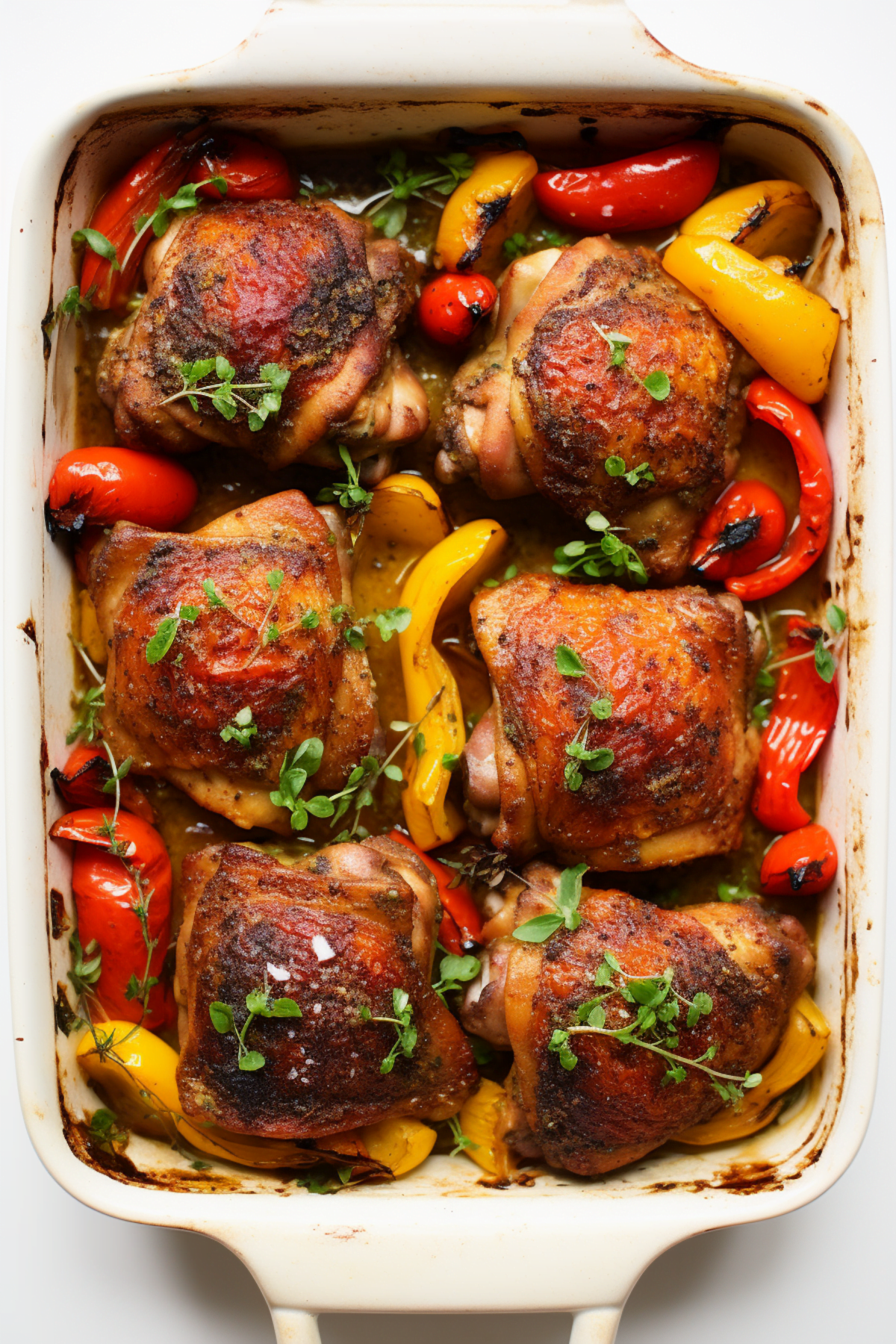Discover the Heart of Basque Cuisine with Poulet Basquaise
Embark on a culinary journey to the Basque Country with our exquisite Basque Chicken with Peppers and Tomatoes, also known as Poulet Basquaise. This traditional dish is a symphony of flavors, showcasing the simplicity and richness of Mediterranean cooking. Here, you’ll find a recipe that not only warms the soul but also brings a piece of Basque heritage to your table.
Whether you’re a seasoned chef or a home cook, this recipe is designed to guide you through each step, ensuring a delightful and authentic experience. Let’s dive into the vibrant world of Basque cuisine and transform your dinner into a festive occasion with this beloved regional classic.
Get ready to impress your guests with a dish that’s as visually stunning as it is delicious. With its succulent chicken, sweet peppers, and robust tomatoes, Poulet Basquaise is sure to become a staple in your recipe collection.
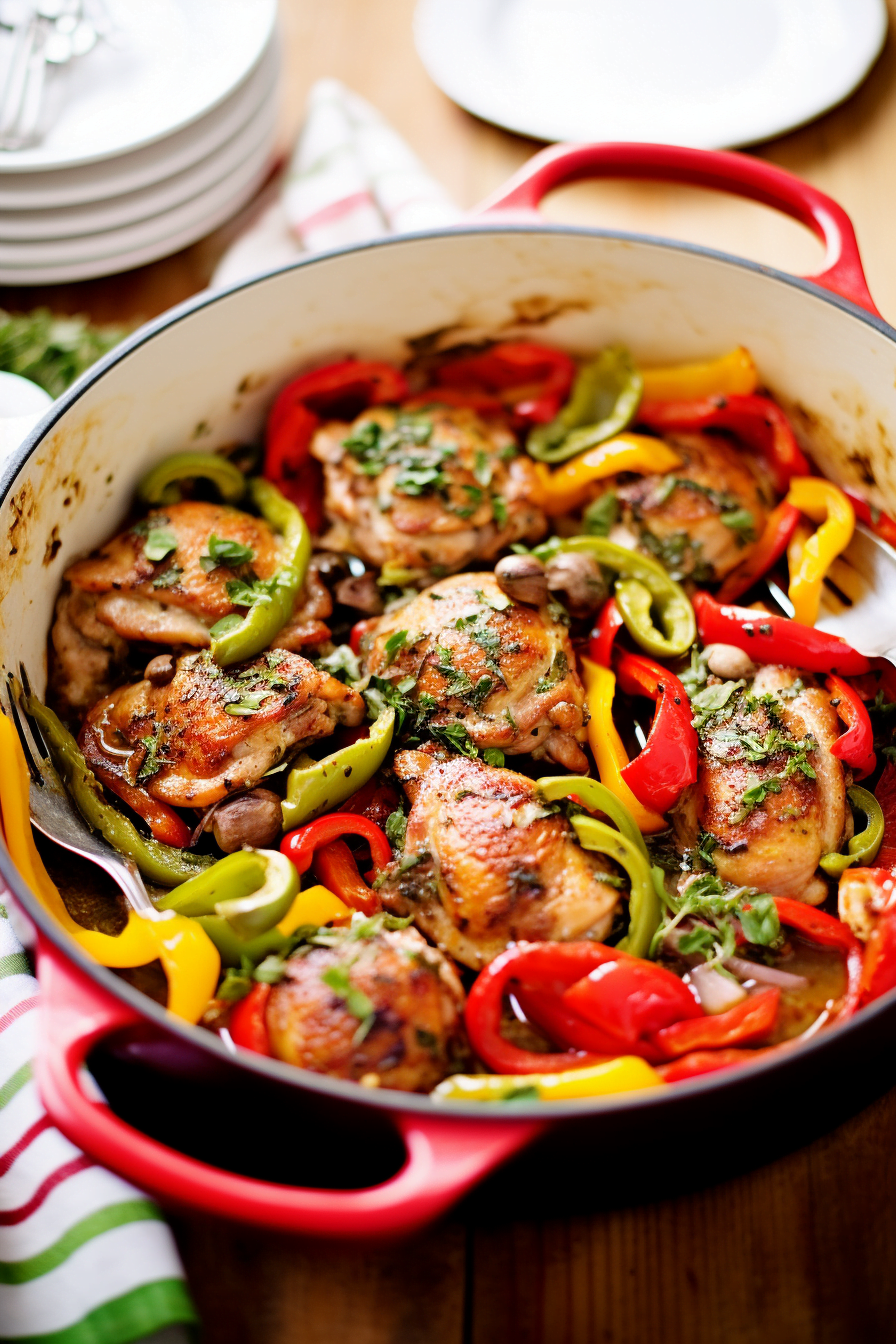
The Story Behind Poulet Basquaise
Originating from the Basque region that straddles the border between France and Spain, Poulet Basquaise is a dish deeply rooted in tradition and local ingredients. The Basque people, known for their rich history and unique culture, have cultivated a cuisine that reflects the diversity of their landscape, from the Pyrenees mountains to the Bay of Biscay.
The heart of this dish lies in the use of piperade, a sauté of bell peppers, tomatoes, and onions, which is a cornerstone of Basque cooking. The peppers, known locally as piments doux, are the soul of the piperade, providing a sweet and slightly smoky flavor that is quintessentially Basque. The tomatoes add a bright acidity, while the onions offer a subtle sweetness, creating a harmonious base for the chicken to nestle into.
Traditionally, Poulet Basquaise is prepared with chicken that’s been reared in the Basque Country, ensuring a depth of flavor that’s hard to replicate. The dish is a celebration of the region’s produce, with each ingredient playing a pivotal role in the final taste. The inclusion of smoked paprika is a nod to the Spanish influence, adding a layer of complexity to the dish.
As you cook this recipe, you’re not just preparing a meal; you’re participating in a ritual that has been passed down through generations. The slow simmering of the sauce, the careful browning of the chicken, and the final baking all contribute to a dish that is more than the sum of its parts. It’s a true homage to the Basque way of life, where food is a form of communication and an expression of community.
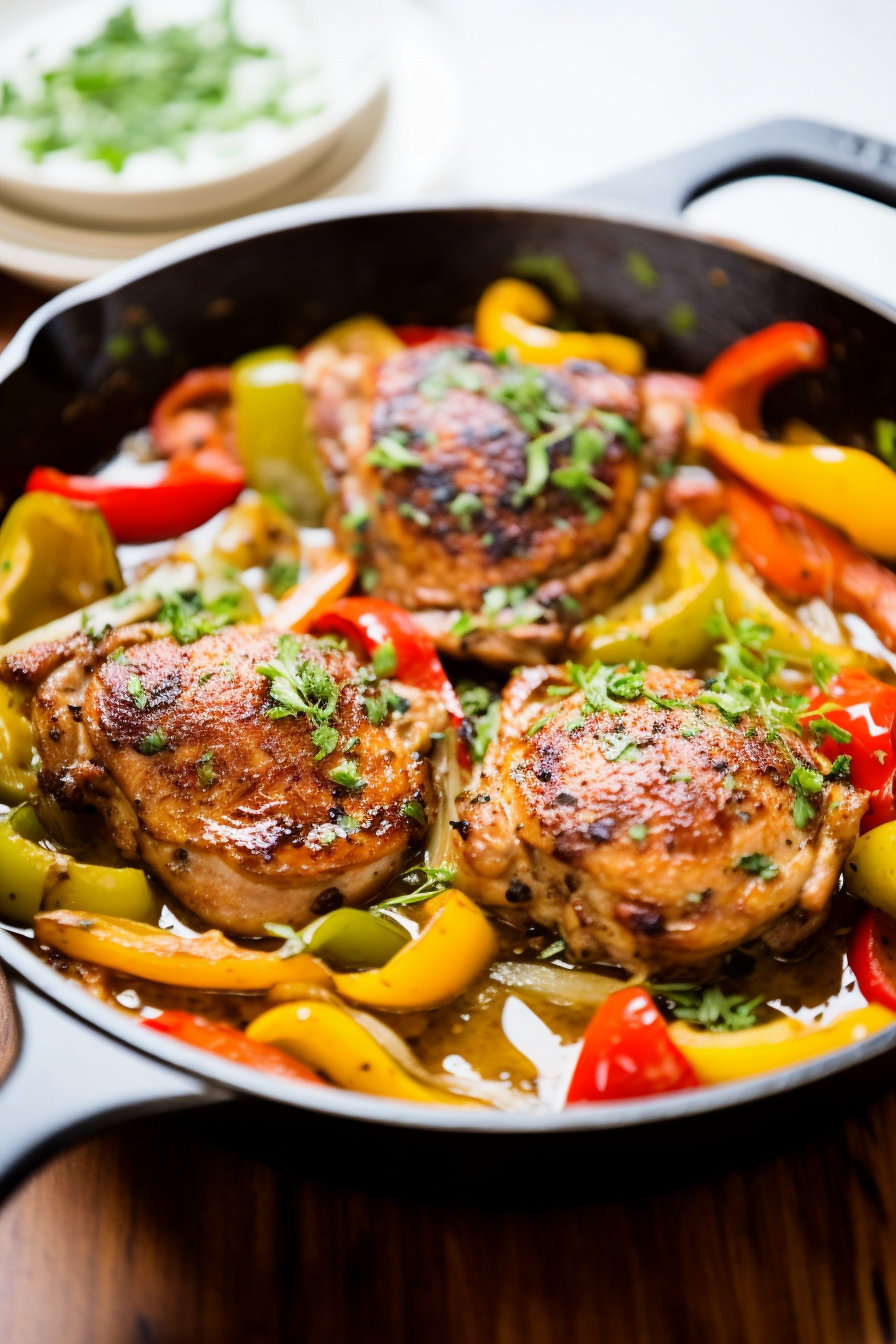
Mastering the Method for Poulet Basquaise
Creating the perfect Poulet Basquaise is an art that requires attention to detail and a love for the process. Begin by selecting the freshest vegetables and the highest quality chicken you can find, as these are the cornerstones of the dish. Seasoning the chicken generously with salt, pepper, and smoked paprika is crucial for building layers of flavor.
The searing of the chicken is a step you don’t want to rush. Achieving that golden-brown crust not only adds texture but also locks in the juices, ensuring each bite is succulent. When sautéing the vegetables, allow them to soften and caramelize slightly. This caramelization is key to developing the sweet and savory foundation of the sauce.
When deglazing with white wine, take a moment to scrape up all the browned bits from the bottom of the pan. These bits are packed with flavor and will enrich the sauce. As the dish bakes, the magic happens. The chicken becomes tender, the sauce thickens, and the flavors meld together beautifully. If you’re after a crispy skin, remove the lid or foil towards the end of the baking time to let the skin crisp up.
Remember, the beauty of Poulet Basquaise lies in its rustic charm. There’s no need for perfection in presentation; it’s the homely, hearty nature of the dish that makes it so appealing. Serve it directly from the skillet or Dutch oven for an authentic touch, and don’t forget to garnish with fresh parsley for a pop of color and freshness.
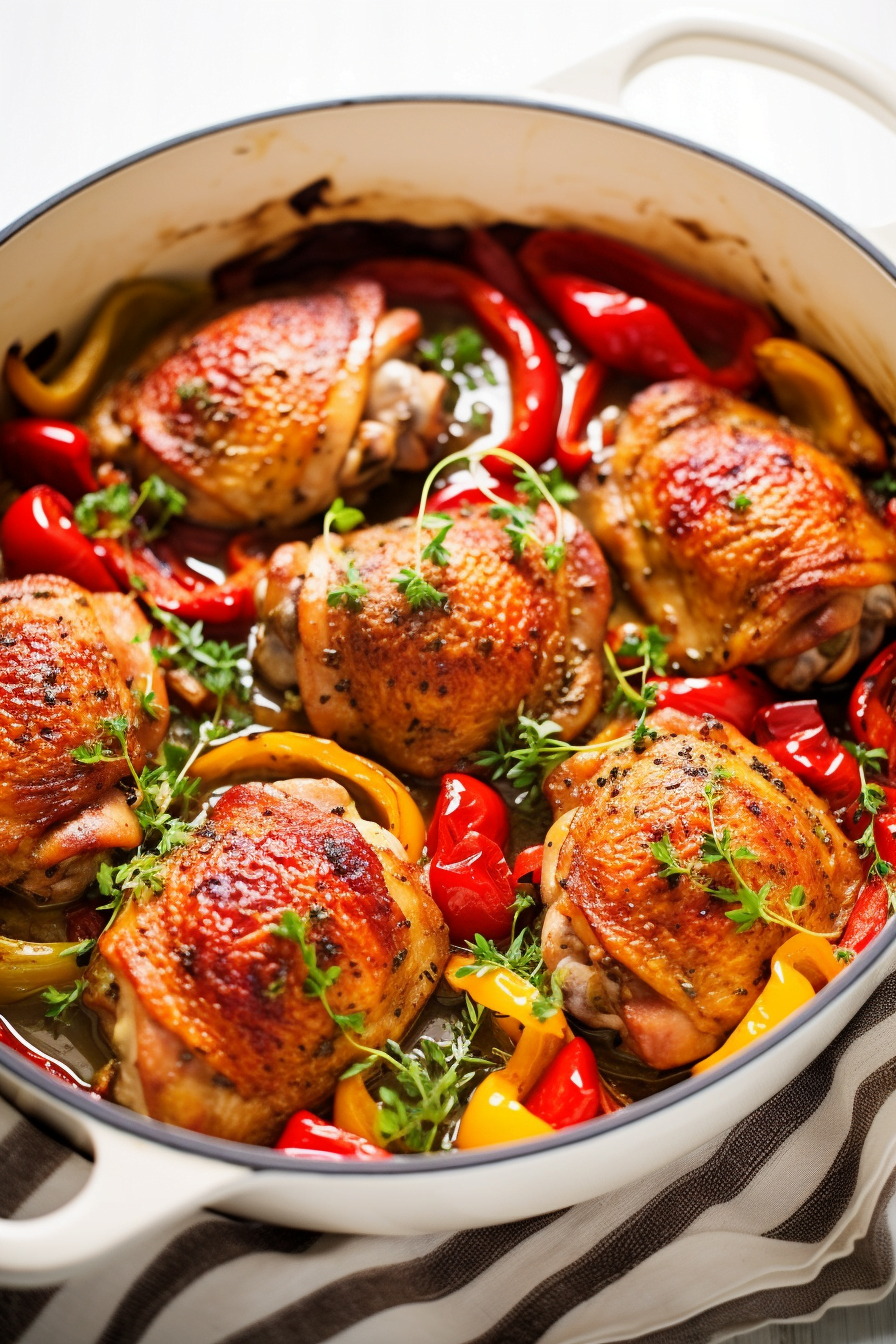
Variations of Poulet Basquaise
Seafood Twist: For a pescatarian version, replace the chicken with firm white fish or shellfish like prawns. The delicate flavors of seafood complement the piperade beautifully, creating a lighter yet equally satisfying dish.
Vegetarian Basquaise: Omit the chicken and add a variety of beans for protein. Chickpeas or white beans work wonderfully, absorbing the flavors of the sauce and adding a satisfying texture to the dish.
Spicy Basquaise: For those who enjoy a bit of heat, incorporate some Espelette pepper, a staple in Basque cuisine, or a pinch of cayenne pepper. This will give the dish a gentle warmth that builds with each bite.
Substitutions for Poulet Basquaise
Wine Alternatives: If you prefer not to use wine, a good quality chicken or vegetable broth can be used to deglaze the pan. The broth will still lift the browned bits and add depth to the sauce.
Tomato Options: Fresh, ripe tomatoes can be used in place of canned if they’re in season. Simply peel, seed, and chop them before adding to the skillet.
Herb Varieties: While thyme is traditional, feel free to experiment with other herbs like rosemary or bay leaves. Each herb will impart a different nuance to the dish, allowing you to customize it to your taste.
Frequently Asked Questions About Poulet Basquaise
Can I make Poulet Basquaise ahead of time? Yes, this dish actually tastes better the next day as the flavors have more time to meld. Just reheat gently on the stove before serving.
Is it necessary to use an oven-proof skillet? If you don’t have one, you can transfer the contents to a baking dish covered with foil before placing it in the oven.
Can I use chicken without skin and bones? Bone-in, skin-on chicken is recommended for flavor and juiciness, but you can use boneless, skinless cuts if you prefer. Just adjust the cooking time accordingly.
What can I serve with Poulet Basquaise? It pairs beautifully with steamed rice, crusty bread, or even creamy polenta to soak up the sauce.
How can I store leftovers? Store in an airtight container in the refrigerator for up to 3 days. You can also freeze it for up to 3 months.
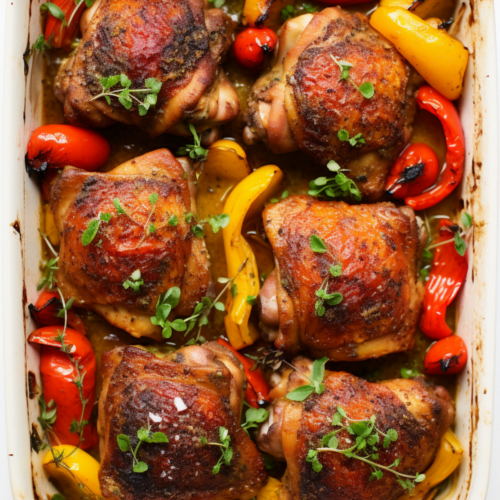
Basque Chicken with Peppers and Tomatoes (Poulet Basquaise)
Equipment
- Oven-proof skillet or Dutch oven
- Cutting board
- Chef's knife
- Measuring cups and spoons
- Aluminum foil (if needed)
Ingredients
- 4 bone-in, skin-on chicken thighs (approx. 1.5 lbs or 680g)
- 2 bone-in, skin-on chicken breasts (approx. 1 lb or 450g)
- 2 red bell peppers, sliced (about 1 lb or 450g)
- 1 green bell pepper, sliced (about 0.5 lb or 225g)
- 1 large onion, thinly sliced (about 0.5 lb or 225g)
- 4 cloves garlic, minced
- 1 can diced tomatoes (14 oz or 400g)
- 1/2 cup dry white wine (120 ml)
- 1/4 cup extra virgin olive oil (60 ml)
- 1 tsp smoked paprika (2g)
- 1/2 tsp dried thyme (1g)
- Salt and pepper to taste
- 1 tbsp fresh parsley, chopped for garnish (3g)
Instructions
- Preheat your oven to 350°F (175°C).
- Season the chicken pieces with salt, pepper, and smoked paprika.
- In a large oven-proof skillet or Dutch oven, heat the olive oil over medium-high heat. Add the chicken, skin-side down, and sear until the skin is golden brown, about 5 minutes per side. Remove the chicken and set aside.
- In the same skillet, add the sliced onions and peppers. Sauté until the vegetables are softened, about 8-10 minutes.
- Add the minced garlic to the skillet and cook for another minute until fragrant.
- Deglaze the skillet with the dry white wine, scraping up any browned bits from the bottom of the pan.
- Stir in the diced tomatoes and dried thyme, and bring the mixture to a simmer.
- Return the chicken to the skillet, nestling the pieces into the vegetable mixture.
- Cover the skillet with a lid or aluminum foil and transfer to the preheated oven. Bake for 40 minutes.
- Remove the lid or foil and bake for an additional 10 minutes to allow the chicken skin to crisp up.
- Garnish with fresh parsley before serving.
Notes

